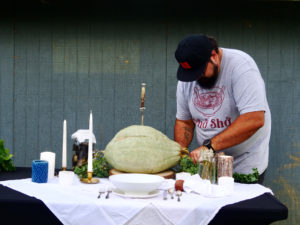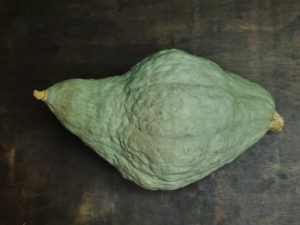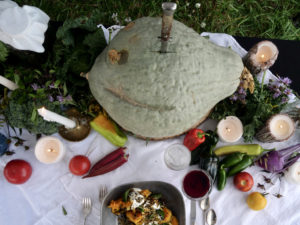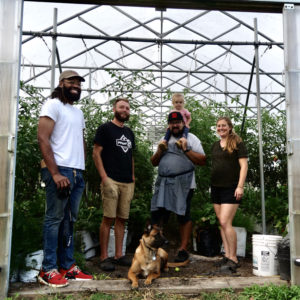In Search of the Great Pumpkin
Words by Rasul Welch
Photos by Barry Jarvis
It wasn’t a typical fall pursuit. The search was more difficult not just because farms need notice for such things but also because it was a particularly unusual year.
We were coming out of a global pandemic, only to return to surges from new variants. New challenges in labor and supply made the problems we faced during the shutdown all disappear from memory.
We knew many of the difficulties that new restaurants face. So when we opened Farmer’s Feast in May, we planned accordingly. Despite a few construction-related hiccups, our plan was working. With the holidays in sight, parties were quickly booked. We had written the menus and placed the necessary farm orders. Our fledgling enterprise seemed to be on a trajectory of its own. All we needed to do was stick to the plan.
Then I got a call from a friend in Detroit.
 It had been a year since Jason passed. A group of chefs from Kentucky to New York City were planning a feast in his memory. When he succumbed to an undiagnosed heart condition, Jason was a young Detroit chef with a blossoming family and career. He’d beaten the demons that previously kept him from both. He had served his time in prison, nurturing his positive attributes and studying food voraciously. On release, he had an indomitable focus to be the best father, chef, and partner he could be.
It had been a year since Jason passed. A group of chefs from Kentucky to New York City were planning a feast in his memory. When he succumbed to an undiagnosed heart condition, Jason was a young Detroit chef with a blossoming family and career. He’d beaten the demons that previously kept him from both. He had served his time in prison, nurturing his positive attributes and studying food voraciously. On release, he had an indomitable focus to be the best father, chef, and partner he could be.
Jason was an inquisitive polymath. He could master seemingly any craft within one year. His sculptures are still on display at his alma mater in Atlanta two decades after he graduated. Though I never saw him sculpt, I did see him learn to make incredible cheeses and salumi.
I come from a multinational, multicultural family. My earliest food memories are making flatbreads with a Nepali cook named Raju and lamb meatballs with my Gujrati great-grandfather. An auntie from Goa showed me how to make pungently savory preserves from tiny dried shrimp. An uncle from Kerala introduced me to the toasty coconut chili chutney they make there. From a restaurateur in Flushing, New York, I learned about the incredible fusion of Northern Indian and Chinese cuisines found in the noodle shops of Tangra, Kolkata.
Somehow, despite my expertise in the subject, my first time cooking with Jason was like a master course in Indian cuisine. Though he would vehemently deny it, I learned much more from him than he from me.
Indian food was just one of the hundreds of pockets of knowledge that made up his culinary acumen. The man had a truly encyclopedic knowledge of ingredients and techniques. The centerpiece of a dinner honoring him needed to be unusual and spectacular enough to reflect that.
We chefs planning the feast all knew Jason through his work as a butcher and charcutier—someone who cures and preserves meats. We were all carnivores, and talk of the main entree initially revolved around fantastical meat preparations.
Perhaps it should be a steamship round. We could age an entire leg of beef in Japanese shio koji before roasting it over sassafras. Or what about a whole pig? We could stuff it with cured meats and wild mushrooms and baste it with homemade mead! Both options were deliciously over the top. Choosing between them would be very difficult.
 I don’t remember who came up with the most outrageous idea but we all immediately dismissed it out of hand: What if the centerpiece wasn’t animal-based at all? We were all stuck on images of vegetables stitched and shoved together in a strange facsimile of meat—Frankenstein’s monster in culinary form, just as grotesque and unappealing. Something nagged at the back of my mind, though. A memory I couldn’t quite access.
I don’t remember who came up with the most outrageous idea but we all immediately dismissed it out of hand: What if the centerpiece wasn’t animal-based at all? We were all stuck on images of vegetables stitched and shoved together in a strange facsimile of meat—Frankenstein’s monster in culinary form, just as grotesque and unappealing. Something nagged at the back of my mind, though. A memory I couldn’t quite access.
The thought came back to me in August when our small family garden started to produce summer squash. I remembered years earlier when a farmer friend gave me a squash that had grown too big to sell.
Hubbard squash, he told me, would do that. He said they tasted sweet and buttery and would grow to incredible sizes if you let them. A pretty, pale shade of teal, folks tended to buy them as fall decorations. He assured me this Hubbard would last outside for several months without rotting. I thanked him for the gift and called Jason to see if he had ever come across one.
My friend was excited on my behalf. Not only had he heard of them, but Hubbard squash was one of his favorite fall ingredients. “You can age it like a prosciutto!” he all but yelled into the phone. “Age the big ones in your basement for as long as six months. The longer you age them, the sweeter and deeper the flavor gets!”
That story sealed it for the group. We needed to find and age the biggest and most beautiful Hubbard we could. Sadly, between a wet summer and lack of demand, they weren’t growing large. Heinen’s had plenty from the auction in Amish country, but their buyers had selected small ones more suited for home ovens than for our grand designs.
It occurred to me that the one person I hadn’t asked about them was my friend who had introduced me to Hubbards in the first place. I realized I hadn’t spoken with my friends at Front 9 Farm in at least a year.
 Casondra and Jimmy have always focused on their CSA and market sales. When the pandemic came, they were already positioned to meet the demand. I focused on helping farms that sold to restaurants pivot to consumer sales.
Casondra and Jimmy have always focused on their CSA and market sales. When the pandemic came, they were already positioned to meet the demand. I focused on helping farms that sold to restaurants pivot to consumer sales.
Reconnecting with Jimmy was easy. He assured me they had plenty of big, beautiful Hubbard squash ready to go. When I arrived at the farm, he and Casondra greeted me warmly and took me tomato tasting. And there, in the back room of their golf-course-clubhouse-turned-family-home, was a Hubbard squash.
Hubbards can be a bit intimidating. They’re enormous and have thick skin. To break one down raw, you’ll probably need a hatchet or saw. I find it much easier just to cook them whole. Just poke a hole in the top with a sturdy knife. (I recommend using a hand-carved Italian switchblade if you have one handy.) Two hours in a 400°F oven or grill will do nicely.
Once roasted, Hubbard squash is one of the most versatile ingredients you can find. Fantastic in pies and soda bread, it is also excellent in savory applications. The flavor is intense but balanced. Sweet, savory, rich, and vegetal.
